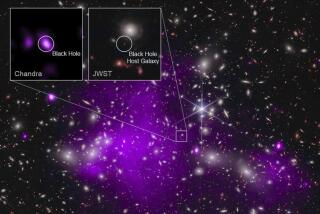Hubble spots distant galaxies near edge of universe’s cosmic dawn
- Share via
Squinting deep into the universe, the Hubble Space Telescope has picked out what may be the most distant galaxy yet found, observed as it looked about 380 million years after the big bang. This potential record-breaker is one of seven newly discovered galaxies formed more than 13 billion years ago, near the cosmic dawn, the era when the first big galaxies formed.
“These galaxies are so young that they existed before many of the atoms in our bodies existed,” said James Bullock, a UC Irvine physics and astronomy professor who was not involved in the study.
The work, accepted for publication by the Astrophysical Journal Letters, helps researchers learn about the building blocks that helped form the universe we know today, said Harvard astronomy professor Avi Loeb, who was not involved in the study.
A team of scientists led by Caltech astrophysicist Richard Ellis used NASA’s famous orbiting telescope to look deep into a slice of sky known as the Hubble Ultra Deep Field. They hoped to pick up signs of distant galaxies as close to the edge of the universe as Hubble could see, because as scientists look deeper into space, they’re also looking farther back in time.
They do so by measuring what’s known as redshift of the light they see coming from a galaxy. As the universe rapidly expands and the galaxies speed up, light from those galaxies stretches out into longer, and redder, wavelengths. Astronomers can measure this redshift to determine how fast an object is moving away, and thus how far away it must be. The more extreme the redshift, the farther it must have traveled, and the older Hubble’s snapshot of it is.
Astronomers have a good grasp of how the universe began – in a big bang, roughly 13.7 billion years ago – because they see evidence from the cosmic background radiation that permeates the universe. They have a good sense of its adolescence and adulthood, because telescopes can look far enough into space to capture snapshots of what it looked like millions and billions of years into the past. But this period lasting a few hundred million years after the big bang remains something of a mystery, Ellis said – and this study helps to start filling in the gaps.
One question that theoretical astronomers have toyed with is whether the once-dark universe began to light up all at once, as ultraviolet light from the growing number of stars and coalescing galaxies ionized surrounding gas, rendering the universe transparent and allowing us to see into the distant past. The sloping decline of the number of galaxies as the astronomers looked farther back in time suggest that this was a gradual process, not a sudden one, Ellis said.
The galaxies the team found were formed about 350 million to 600 million years after the big bang, when the universe was less than 4% of its present age – practically a toddler. But this is about as far back as astronomers can look for now, Ellis said; Hubble’s successor, the James Webb Space Telescope, will look even deeper into the infrared wavelengths of light and should pick up more galaxies hovering even closer to the universe’s birth.
Follow me on Twitter @aminawrite.







